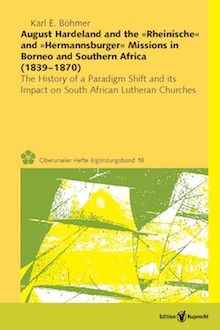Rezension
Exchange 45 (2016)
Dr. Böhmer is lecturer in ›church history‹ at the Lutheran Theological Seminary in Tshwane, South Africa. He wrote a dissertation on the person and work of the German August Hardeland (1814–1891), and defended it at Concordia Theological Seminary, Fort Wayne, USA. The printed version is dedicated to the Lutheran churches of Southern Africa and enriched with a foreword written by Matthew C. Harrison, the president of the Lutheran Church Missouri Synod in the USA.
Böhmer divides his academic study in three sections. The first one deals with the birth, youth, adolescence and education of Hardeland, as well as with his missionary service at Borneo, nowadays Kalimantan. During his first stint (1839–1845) he worked as a missionary of the Rhenish Mission Society (Rm G) among the Dayaks, and married there the Dutch teacher Sarah Hulk, who was seven years older. During his second stint (1849–1859) at in Borneo Hardeland served the Nederlands Bijbel Genootschap (NBG – Netherlands Bible Society) as a translator of the Bible into the Dayak language. In between these periods Hardeland, his wife and their adoptive daughter stayed in South Africa where he continued his linguistic studies and did missionary work (1845–1848), and travelled to Europe (1849). They used their stay in Europe to visit Amsterdam, the city of the headquarters of the NBG, and Hanover, the residence of family members to whom they entrusted their adoptive daughter.
The second part of the study deals with Ludwig Harms, outside Germany known as Louis Harms (1808–1865), the founding father of the Hermannsburg Mission Society (HMS), which wanted to do missionary work in Africa. After the collapse of its missionary endeavour among the Oromo in Ethiopia (1853), it started missionary work among the Zulu people in Natal, South Africa and founded there New-Hermannsburg (1854). Additionally the HMS started, at the request of the ruler of the Bakwena, missionary work among the Batswana.
The third part of the study describes and analyses the relationship between Hardeland and Harms. Ignoring the conflicts of Hardeland with his colleagues during his second stay in Borneo, Harms appointed Hardeland as ›a man of peace‹ to serve as the first Superintendent of the HMS in South Africa. Subsequently this final part calls attention to the many conflicts which characterize the ministry of Hardeland in South Africa (1859–1864): conflicts with fellow missionaries, with the indigenous African people, with the colonists, and growingly with Harms and the HMS. It does not systematically discuss the role of Hardeland’s wife in these conflicts, including the question whether inside their marriage conflicts occurred regarding their encounter with other people. The third part, and in that way the whole study, ends with a summary in German language, ›Der Hardeland-Konflikt‹.
It is obvious that the author, living in South Africa, is more interested in the stay and work of Hardeland in South Africa than in Borneo. Nevertheless he carefully investigated the Indonesian period. In that period Hardeland started to produce a grammar and a dictionary of the Dayak language (completed in 1858 and 1859 respectively), and a Dayak Bible translation (completed in 1858). These publications were recognized in and outside academia in Europe. The Faculty of Theology in Utrecht University offered Hardeland an honorary doctorate for his Bible translation, and the Faculty of Arts in Halle University for his grammar. Böhmer did not point to the fact that the NBG influenced this decision of Utrecht University in one way or another.
Nearly every foreign missionary experiences conflicts, but Hardeland more than most. This fact is due to his character and his misbehaviour, on the one hand, and to his competence for the various tasks at the mission field and his theological and missiological insights, on the other hand. Böhmer sketches the serious conflict between Harms and Hardeland as a very complex matter. He makes clear that this conflict reflects their views on paradigms and the need of paradigm shifts on the mission field.
The study under consideration is an innovative piece of work. First of all, it challenges the nineteenth century concept of missionaries as ›heroines‹ (Daniel C. Eddy1850; Emma R. Pitman 1880), and ›heroes‹ (Lucius E. Smith 1857; W. Pakenham Walsh 1890). Moreover, it invites contemporary church and mission historians to reflect very carefully on conflicts as complicating factors in overseas missions which can influence the life and work of indigenous churches for decades. Finally, it stimulates biographical studies in general, and cross-cultural studies of the lives of persons especially. Although the publication of Böhmer is not the first study on Hardeland, it excels its predecessors who by and large limited themselves to either Hardeland in Indonesia or Hardeland in South Africa.
Jan A.B.Jongeneel








